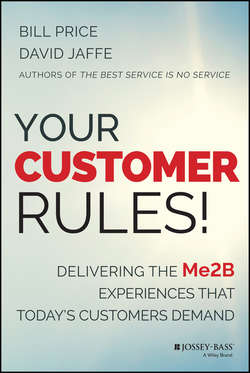Читать книгу Your Customer Rules! - Bill Price - Страница 9
На сайте Литреса книга снята с продажи.
Chapter One
From B2C to Me2B
Back to Fundamentals in the Me2B Era
ОглавлениеNot all is lost. Some businesses today are thriving at delivering the experience that customers need. We call these customer experience heroes Me2B Leaders. They understand that the customer rules. They are outpacing their competition in sales growth, profitability, customer and employee retention, and other key metrics. Companies like Amazon, Apple, Disney, IKEA, John Lewis, Lego, Nordstrom, Southwest Airlines, USAA, and Virgin are household names and often appear in published rankings of best customer experience.10
However, some of the Me2B Leaders are younger, rapidly expanding companies like Shoes of Prey or companies well known in their own countries such as Vente-Privee in France or Yamato Transport in Japan, but less known outside their home markets.
We were motivated to write this book as a way to find out how these companies are succeeding while others struggle, and to help both new and legacy businesses adapt. We sought out many of these Me2B Leaders, interviewing managers, customers, and vendors and suppliers, adding secondary analyses including social chatter and what we call WOCAS, data showing “what our customers are saying.”
The more we learned, the more our original hunch was confirmed: Me2B customers are still looking for the same things they always have. Fundamental customer service needs haven't changed. What has changed is businesses' ability to recognize and deliver on these needs. Now that your customer rules, delivering to the needs is more important and more complex since customers have more information and more choice for interaction methods.
Me2B Leaders, we've found, are creating experiences that don't just deliver a product but fulfill relationship needs that are fundamental and predate even the mom-and-pop era. They are by no means radical innovations. The innovation the Me2B Leaders have brought is in figuring out how to deliver these fundamentals in today's world of scale and channel complexity and to connect to the customer even with the tyranny of scale and distance that separates head offices from the front line and the consumer.
Customers today still want to be recognized and served as they would have been in their local corner store – but in a digital world, the shape of this service is entirely different. For example, customers who shop an online grocery store expect the website to remember their standard weekly order in the same way that the local butcher could reel off a customer's regular order. The medium is changed; the need has not.
As we studied these Me2B Leaders we saw a pattern emerge in the ways that these companies are recognizing and satisfying customer needs and building lasting relationships. We have called these the Seven Customer Needs for Me2B success. The language we use to describe them takes the customer's point of view:
1. You know me, you remember me.
2. You give me choices.
3. You make it easy for me.
4. You value me.
5. You trust me.
6. You surprise me with stuff I can't imagine.
7. You help me be better and do more.
The challenge of meeting these needs will guide the vital strategies that businesses need to adopt in order to sell and serve in the Me2B world. Over the course of this book we show you what they are and how they connect to fundamental relationship needs. We demonstrate how the Me2B Leaders are satisfying these needs. We also clearly illustrate via examples what success and failure look like and outline the obstacles to success.
The seven customer needs are not created equal. Not unlike Maslow's famous hierarchy, they form a pyramid (see Figure 1.1). The first three (Know Me; Give Me Choices; Make It Easy) are fundamental to most interactions and form the bedrock for all Me2B relationships to deliver great customer experiences.
Figure 1.1 The Hierarchy of Customer Needs.
Companies that fulfill the next two needs (Value Me; Trust Me) are more mature in becoming Me2B Leaders; they truly see themselves in a two-way, meaningful relationship with customers, and they have recognized that customers do, and should, have more control. Those companies delivering the final two needs show greater maturity still. They need not deliver on these needs all the time, just in carefully chosen moments that make a powerful and meaningful impact on the customer and demonstrate a willingness to invest in relationships for the long term.
10
Temkin Group. 2014. “Top 10 in 2014 Temkin Experience Ratings” (cycling entry; requires JavaScript). Accessed May 20, 2014. http://www.temkinratings.com. See also Beyond Philosophy. 2014. “Global Customer Experience Survey 2012–2013, Executive Summary.” Accessed May 20, 2014. Copy can be requested at http://www.beyondphilosophy.com/thought-leadership/global-leaders-survey/.
